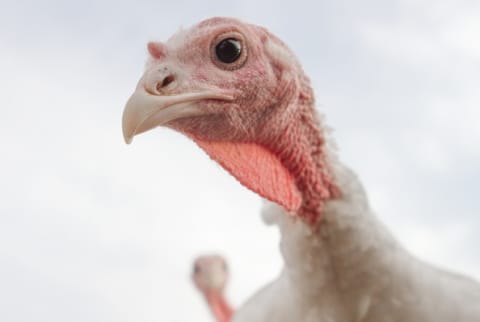Advertisement


If you want to have a traditional Thanksgiving dinner, you probably don't want to skip out on the turkey. We all know it as the main event that unifies all the side dishes. But if you're trying to do right by the bird, you'll want to buy organic — which will lighten your wallet significantly.
At my local Whole Foods in Union Square, an all-natural, certified organic, free-range turkey will cost you $3.99 per pound. If you're feeling fancier than that, a turkey of similar caliber at Dean & Deluca runs at about $6.56 per pound. But a Butterball turkey — guaranteed not organic — from Target is $1.19 per pound.
So, what gives? Why are we being penalized so heavily for doing the right thing?
Well, there are a few major factors that explain this dramatic price difference. Vox investigates:
1. Organic turkey feed is expensive.
Organic feed costs more because it takes a lot more work to grow the organic grains found in it. Without herbicides and insecticides to kill off yield-lowering weeds and bugs, farmers need to give those organic grains a lot more hands-on TLC. David Harvey, the U.S. Department of Agriculture's top poultry economist, said that conventional turkey feed costs around 41 cents a pound on average versus 54 cents a pound at Nick's Organic Farm in Potomac, Maryland.
2. Organic turkey processing is expensive.
The types of products used in organic processing, like cleaning solvent, are more expensive than in conventional processing. Moreover, organic plants can only use certain approved pest-control methods. The special organic processing plants require extensive training for employees, to make sure that non-organic substances don't contaminate organic areas. These plants also need to be inspected regularly and pay a fee to be certified.
3. Organic turkeys have higher health risks.
Since organic turkeys are allowed to roam outside, they can risk death from predators, the elements, and illness, according to Wayne Martin, an extension educator at the University of Minnesota. And of course, you can't treat a sick organic turkey with antibiotics, so farmers are more likely to use all-natural remedies like probiotics, which can be less effective. More risk means more dead birds, leading to smaller supply and steeper prices.
4. Pastured turkey is even pricier.
An organic turkey is required to have a certain amount of time outdoors, but sometimes, farmers will make the "outdoor" space as small as the tight quarters that confined indoor birds inhabit. If you want to guarantee that your bird really roamed free, you'll have to buy a pastured turkey. This is in turn even more expensive, because pasturing alters its feed-conversion ratio — increasing the amount of feed required per pound.
"Pastured birds are just not going to put on weight as quickly as a bird that's grown no more than 50 feet from food," explains Harvey.
5. Organic turkey labor costs are high.
Organic turkey feed is much more labor-intensive than conventional feed. And if you're going the pastured route, keep in mind that pasturing a flock obviously requires more work and more land per turkey than simply confining the turkey to a house.
6. Heritage turkey breed costs are high.
Different types of turkeys put on weight differently. "Broad-breasted" birds are genetically modified to have huge breasts, thus putting on weight more efficiently, taking 16 to 22 weeks to reach market weight with less feed. In contrast, "heritage breeds," the less-genetically-altered birds, don't convert feed as efficiently, taking 26 to 28 weeks to reach market weight with more feed.
So while it might be frustrating to drain your wallet for the sake of one (albeit important) dish, at least you can understand and appreciate what went into raising your exorbitantly-priced centerpiece. And to honor your humanely-raised bird, be sure to treat it with the utmost respect in your kitchen (Don't burn it!).